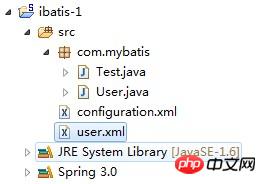How to use Mybatis in Java
In June 2011, iBatis changed its name to MyBatis. From iBatis to MyBatis, it is not just a change in name. MyBatis provides more powerful functions without losing its ease of use. On the contrary, in many places All are simplified with the help of JDK's generics and annotation features. So you know, start learning from MyBatis.
The example uses MyBatis+MySQL to implement a user table query, as follows:
①Database In MySQL, under the test database, the resume user table, fields: id, name, password , the table creation statement is abbreviated.
②There are only two packages that need to be imported: mybatis-3.0.3.jar mysql-connector-java-5.1.16-bin.jar (JDBC package)
③The directory structure adopts the simplest structure. There are only four files configuration.xml user.xml under the com.mybatis package. User.java Test.java

④mybatis configuration file configuration.xml,
[html]
##
<?xml version="1.0" encoding="UTF-8"?>
<!DOCTYPE configuration PUBLIC "-//mybatis.org//DTD Config 3.0//EN" "http://mybatis.org/dtd/mybatis-3-config.dtd">
<configuration>
<typeAliases>
<typeAlias alias="User" type="com.mybatis.User"></typeAlias>
</typeAliases>
<environments default="development">
<environment id="development">
<transactionManager type="JDBC"></transactionManager>
<dataSource type="POOLED">
<property name="driver" value="com.mysql.jdbc.Driver" />
<property name="url" value="jdbc:mysql://localhost:3306/test?useUnicode=true&characterEncoding=UTF-8" />
<property name="username" value="root" />
<property name="password" value="123456" />
</dataSource>
</environment>
</environments>
<mappers>
<mapper resource="user.xml"/>
</mappers>
</configuration><?xml version="1.0" encoding="UTF-8"?>
<!DOCTYPE mapper PUBLIC "-//mybatis.org//DTD Mapper 3.0//EN" "http://mybatis.org/dtd/mybatis-3-mapper.dtd">
<mapper namespace="User">
<select id="selectUser" parameterType="int" resultType="User">
SELECT * FROM user WHERE id = #{id}
</select>
<select id="selectUsers" resultType="User">
SELECT * FROM user
</select>
</mapper>package com.mybatis;
public class User {
private int id;
private String name;
private String password;
public User(){}
public User(int id, String name) {
this.id = id;
this.name = name;
}
public int getId() {
return this.id;
}
public void setId(int id) {
this.id = id;
}
public String getName() {
return this.name;
}
public void setName(String name) {
this.name = name;
}
public String getPassword() {
return this.password;
}
public void setPassword(String password) {
this.password = password;
}
@Override
public String toString() {
return "User [id=" + this.id + ", name=" + this.name + ", password=" + this.password + "]";
}
}package com.mybatis;
import java.io.IOException;
import java.io.Reader;
import java.util.List;
import org.apache.ibatis.io.Resources;
import org.apache.ibatis.session.SqlSession;
import org.apache.ibatis.session.SqlSessionFactory;
import org.apache.ibatis.session.SqlSessionFactoryBuilder;
public class Test {
public static void main(String[] args) throws IOException {
String resource = "configuration.xml";
Reader reader = Resources.getResourceAsReader(resource);
SqlSessionFactory ssf = new SqlSessionFactoryBuilder().build(reader);
SqlSession session = ssf.openSession();
try{
User user = session.selectOne("selectUser", "1");
System.out.println(user.getName());
System.out.println(user);
System.out.println("--------------分隔线---------------");
List<User> users = session.selectList("selectUsers");
for(int i=0; i<users.size(); i++) {
System.out.println(users.get(i).getName());
}
} catch (Exception e) {
e.printStackTrace();
} finally {
session.close();
}
}
}The above is the detailed content of How to use Mybatis in Java. For more information, please follow other related articles on the PHP Chinese website!

Hot AI Tools

Undresser.AI Undress
AI-powered app for creating realistic nude photos

AI Clothes Remover
Online AI tool for removing clothes from photos.

Undress AI Tool
Undress images for free

Clothoff.io
AI clothes remover

AI Hentai Generator
Generate AI Hentai for free.

Hot Article

Hot Tools

Notepad++7.3.1
Easy-to-use and free code editor

SublimeText3 Chinese version
Chinese version, very easy to use

Zend Studio 13.0.1
Powerful PHP integrated development environment

Dreamweaver CS6
Visual web development tools

SublimeText3 Mac version
God-level code editing software (SublimeText3)

Hot Topics
 Square Root in Java
Aug 30, 2024 pm 04:26 PM
Square Root in Java
Aug 30, 2024 pm 04:26 PM
Guide to Square Root in Java. Here we discuss how Square Root works in Java with example and its code implementation respectively.
 Perfect Number in Java
Aug 30, 2024 pm 04:28 PM
Perfect Number in Java
Aug 30, 2024 pm 04:28 PM
Guide to Perfect Number in Java. Here we discuss the Definition, How to check Perfect number in Java?, examples with code implementation.
 Random Number Generator in Java
Aug 30, 2024 pm 04:27 PM
Random Number Generator in Java
Aug 30, 2024 pm 04:27 PM
Guide to Random Number Generator in Java. Here we discuss Functions in Java with examples and two different Generators with ther examples.
 Weka in Java
Aug 30, 2024 pm 04:28 PM
Weka in Java
Aug 30, 2024 pm 04:28 PM
Guide to Weka in Java. Here we discuss the Introduction, how to use weka java, the type of platform, and advantages with examples.
 Armstrong Number in Java
Aug 30, 2024 pm 04:26 PM
Armstrong Number in Java
Aug 30, 2024 pm 04:26 PM
Guide to the Armstrong Number in Java. Here we discuss an introduction to Armstrong's number in java along with some of the code.
 Smith Number in Java
Aug 30, 2024 pm 04:28 PM
Smith Number in Java
Aug 30, 2024 pm 04:28 PM
Guide to Smith Number in Java. Here we discuss the Definition, How to check smith number in Java? example with code implementation.
 Java Spring Interview Questions
Aug 30, 2024 pm 04:29 PM
Java Spring Interview Questions
Aug 30, 2024 pm 04:29 PM
In this article, we have kept the most asked Java Spring Interview Questions with their detailed answers. So that you can crack the interview.
 Break or return from Java 8 stream forEach?
Feb 07, 2025 pm 12:09 PM
Break or return from Java 8 stream forEach?
Feb 07, 2025 pm 12:09 PM
Java 8 introduces the Stream API, providing a powerful and expressive way to process data collections. However, a common question when using Stream is: How to break or return from a forEach operation? Traditional loops allow for early interruption or return, but Stream's forEach method does not directly support this method. This article will explain the reasons and explore alternative methods for implementing premature termination in Stream processing systems. Further reading: Java Stream API improvements Understand Stream forEach The forEach method is a terminal operation that performs one operation on each element in the Stream. Its design intention is






